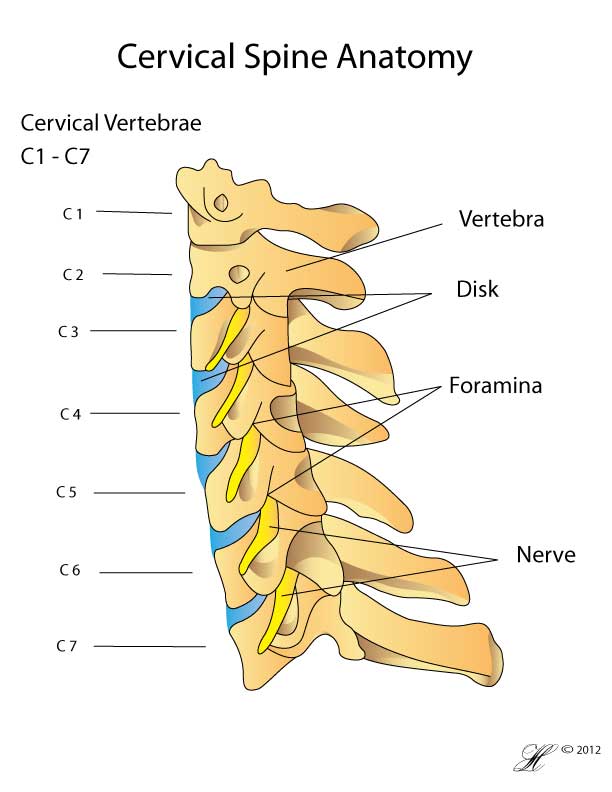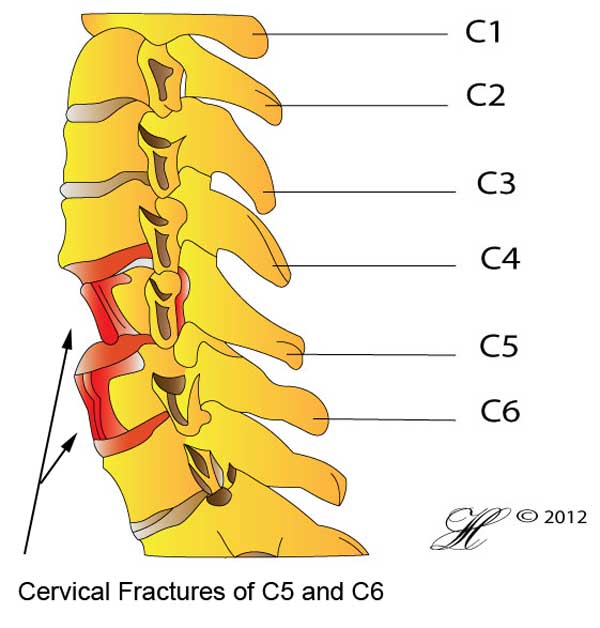There are seven cervical bones (vertabrae) in the neck that support your head and connect it to your shoulders and body. A fracture (break or crack) in one of the cervical vertebrae is called a cervical fracture or a broken neck.
The cervical vertebrae enclose the spinal cord. The spinal cord is where the nerves from your brain go to the rest of the body. With a cervical fracture, the spinal cord may also be damaged.
Hence, a cervical fracture is a medical emergency.

Diagram of the Cervical Spine (neck) showing normal anatomy.
Symptoms
- Pain in your neck with or without movement.
- Difficulty moving your neck.
- Bruising and swelling at the back of your neck.
- Loss of feeling or pin-prick pain in your arms or legs.
- Muscle weakness or paralysis (no movement) of your arms or legs.
- Pain from your neck spreading to your shoulders or arms.
- Difficulty breathing or the inability to take a deep breath.

Causes
A forceful impact, or traumatic blow to the head or/and neck is the most common cause for a cervical fracture:
- Motor vehicle collisions
- Falls
- Sports-related accidents
- High risk sports include football, ice hockey, rugby, skiing and snowboarding, and equestrian sports.
- Collision sports such as football and ice hockey account for the largest number of injuries.
- Interpersonal violence
References
Knaub, M. A. (2005). An Update on Cervical Trauma: Current Epidemiology and Pathophysiology. Seminars in Spine Surgery, 17(2), 63-66.
Risk Factors
The severity of cervical fracture largely depends on the mechanism of injury and mode of impact to the neck and surrounding structures.
Motor vehicle collisions and falls are associated with cervical spine injury. If someone was found to have a pelvic injury or head injury, it is important to rule out a cervical injury as well.
References
Clayton, J. L., Harris, M. B., Weintraub, S. L., Marr, A. B., Timmer, J., Stuke, L. E., et al. (2012). Risk factors for cervical spine injury. Injury, 43(4), 431-435. [Link]
Investigations
For any suspected cervical injury, the neck will be immobilised with a collar.
The emergency doctor will perform the following imaging to determine the extent of cervical injury or before a cervical fracture can be ruled out:
- X-rays of multiple views
- Computed tomography (CT)
- MRI
Other investigations such as blood tests will be performed to check for other injuries in the context of an emergency setting.
Complications
A possible immediate complication of a broken neck is:
- Difficulty breathing – This is a worrying sign. You will be given oxygen via a mask. However if the difficulty in breathing is severe, the doctors will give you medication to make you feel more drowsy and comfortable and put a tube down into your lungs to help you breath.
Other complications of a neck fracture will depend on the extend of injury and whether the spinal cord is affected in the injury with the bones.
- You may continue to experience pain around your neck in the future.
- The distortion around your neck bones from the fracture may:
- Cause bulging (herniation) of the cervical discs.
- Nerve impingement result in shoot pain down your arms.
Depending on how much and where are the nerves in your spinal cord injured, you may experience the following:
- Paraplegia: you may not be able to move both legs.
- Quadriplegia: you may not be able to move both legs and arms.
The above are grouped under the term ‘spinal cord injury’ and are most often permanent.
References
Joslin CC, Khan SN, Bannister GC. Long-term disability after neck injury. a comparative study. J Bone Joint Surg Br. 2004 Sep;86(7):1032-4.
Treatment
Medications
A variety of pain medications will be prescribed by your doctor, depending on the severity of your pain, to help you feel more comfortable. Ask your doctor or pharmacist about the side effects of these medications, some of them can cause you to be sleepy.
Do not wait for the pain to become bad before you tell your doctor about it. It is always better to take enough pain medication as it reduces your anxiety and so you can heal properly.
Immobilisation
Similar to when you break your arm and a cast is put on, your neck will be fixed in place by a collar to allow the neck bones to heal smoothly. The collar will remain on for up to a few months depending on the severity of your injury.
Types of collars include:
- Halo brace: A halo brace and vest prevent most head and neck movements. The halo brace is attached to your head with pins placed in your skull. It cannot be removed during treatment.
- Semirigid collar: Semirigid collars use plastic plates to stop side-to-side or up-and-down motion in your neck.
- Soft collar: A soft collar is a flexible brace placed around the neck. It is often used after a more rigid collar has been worn.
Traction
For more severe injuries, weights will be used to pull your bones back to place and to straighten your spine.
Surgery
Depending on your neck fracture, your doctor may decide you need surgery to fix it. Not everyone requires surgery after a neck fracture so talk to your doctor about it. If the fracture is not healed after prolonged use of a neck collar, surgery may be the next step in your process to healing.
Exercise and rehabilitation
Other health professionals will become involved in your care. This will include:
- The physiotherapist will teach you a few exercises to strengthen your muscles and ligaments to aid with better healing.
- An occupational therapist may have a look at your home surrounding and help modify your environment so you can get around more easily with the injury.
- If your speech and swallowing were affected by the neck fracture, a speech therapist will work with you to try improve in those areas.
Seeking Advice
Your Family Doctor (GP)
Your Family Doctor will be able to diagnose and help treat your problem. He or she will be able to
- tell you about your problem
- advise you of the best treatment methods
- prescribe you medications
- and if necessary, refer you to Specialists (Consultants) for further treatment
Prevention
Vehicle safety technologies
- Seat belt saves lives and minimise risk of cervical spine fractures! – always make sure you and the passengers in your car wear their seat belt at all times.
- Studies have shown that the vehicle safety technologies (air bags, child safety seats, side impact protection, front disc breaks etc.) have saved more than millions of lives since they came into implementation in the 1960s.
Protective sports gears
- Wear a protective face and head helmet when playing high risk or collision sports.
- Where possible, use cushions to reduce impact of falls.
- Never dive into a shallow pool.
References
McIntosh AS, McCrory P. Preventing head and neck injury. Br J Sports Med. 2005 Jun;39(6):314-8.
F.A.Q. | Frequently Asked Questions
What to expect after a neck fracture?
- Recovery from neck fractures depends on the extent of the injury.
- Fractures may take 6 to 12 weeks to heal.
- About 90 percent of those with a spinal cord injury are able to live independently.
